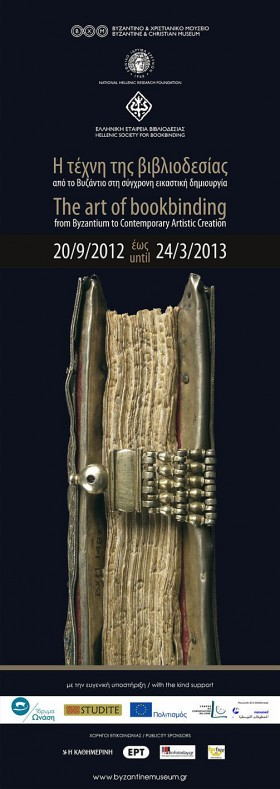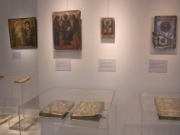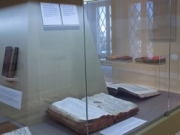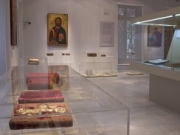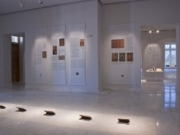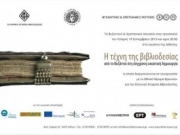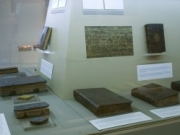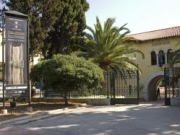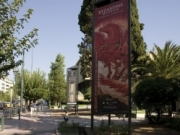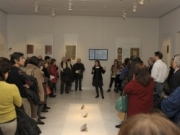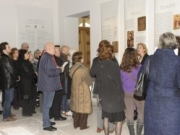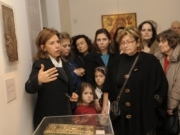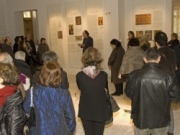'The Art of Bookbinding: From Byzantium to Contemporary Artistic Creation'
Founded in 1914, the Byzantine and Christian Museum is one of the oldest museums in Greece devoted exclusively to Byzantine art and civilization. The whole of the museum’s collection of manuscript codices and incunabula highlights valuable material. The chronological range and varied geographical origins of this material tellingly elucidate the history and use of Byzantine and post-Byzantine codices, and especially the evolution of writing, illustration, and bookbinding.
This exhibition is intended to highlight the particular art of bookbinding through an overview of its historical evolution—from Byzantium to our times—and to introduce the visitor to a different visual approach to books. Bookbinding is directly linked to the social history of the book, the use and function of manuscripts and printed books, and it reflects matters of collective mentalities rather than individual creation.
The books from the collection of manuscripts and incunabula of the Byzantine and Christian Museum and the Greek Library of the Alexander S. Onassis Public Benefit Foundation which are exhibited are excellent specimens of bookbinding techniques. But first and foremost these books represent important stages in the historical development of bookbinding. Dating from the 11th to the 19th centuries, they originate from the wider Greek mainland, the east Mediterranean, the Balkans, and the West.
The Library of the Alexander S. Onassis Public Benefit Foundation, in supporting Greek literature and art, integrated in its collections the Constantine A. Staikos Library, which ranges from the early Renaissance to the later years of the neo-Hellenic Enlightenment. This particular collection is significant largely because it sheds light on printing activity even in the remotest regions of Greek communities, and brings together the various elements that demonstrate the development of the art of bookbinding.
The illustrations in the collection of the Byzantine Museum presented in the exhibition bring out the role of the book and its depiction in Byzantine and post-Byzantine iconography. The development of the art of bookbinding from the codex to the printed book in the 19th century is shown through texts and audiovisual material. In exploring current readings of the tradition of the book as an art form, the exhibition has included contemporary artistic creations. Dimitris Xonoglou’s installation approaches the book as an object of figurative use. Venia Dimitrakopoulou’s creations are inspired by the Japanese tradition of bookbinding. The six collector’s copies of the book Kassiane the hymnodist are each illustrated by an artist—Markos Kampanis, Christos Markidis, Christos Bokoros, Kostas Papatriantafyllopoulos, Fotini Stefanidou, and Panos Fidakis. All of these works are creative components of the exhibition and boldly connect the past with the present.
The exhibition stems from the European programme ‘Studite’, which includes six participating European countries and which is concerned with the study of Byzantine and post-Byzantine bookbinding. It is hoped that this programme will contribute to the development of interdisciplinary and intercultural dialogue.
The exhibition is the culmination of a ten-year cooperation between the Byzantine Museum, the National Hellenic Research Foundation, and the Hellenic Bookbinding Society.
General Coordination
Anastasia Lazaridou
Curators
Anastasia Lazaridou-Niki Tsironi
Exhibition consultants
Costas Staikos, Babis Legas
Academic associate
Zissis Melissakis
Translation of texts
Ioannis Petropoulos
LENDER OF WORKS
Alexander S. Onassis Foundation
THE NATIONAL HELLENIC RESEARCH FOUNDATION (NHRF), established by royal decree on 9 October 1958, is one of the most important research centres in the country. Its mission is the organisation and conduct of interdisciplinary research in the humanities and positive sciences. The Institute of Byzantine Research now a department of the Institute of Historical Research) has been a participant in the research programme ‘The Book in collaboration with the Byzantine Museum and the Hellenic Bookbinding Society since 2002. The programme has entailed the implementation of works of national and wider European scope, on-site investigations in libraries and collections, exhibitions, and an international conference under the same name whose proceedings were published by the three participating Chrysochoides, and curated by Niki Tsironi and special research associate Zissis Melissakis. Byzantium: Byzantine and post-Byzantine Bookbinding’ in institutions. The programme is supervised by Kriton Chrysochoides, and curated by Niki Tsironi and special research associate
Zissis Melissakis.
THE HELLENIC BOOKBINDING SOCIETY was established in 2002 by scholars and other intellectuals. The founders were instrumental in the publication of the scholarly journal Vivlioamphiastis, dedicated to the interdisciplinary study of bookbinding in Greece and the wider region of the Balkans and the east Mediterranean. In this connection the Society has carried out on-site missions in libraries and collections, exhibitions devoted to the art of bookbinding (Mesolonghi 2002, Ioannina 2003, Drama 2003), and publications on the subject. The Hellenic Bookbinding Society has also published two volumes of the periodical journal Vivlioamphiastis and a third volume in cooperation with the Byzantine and Christian Museum and the National Hellenic Research Foundation. The proceedings of the 6th International Symposium of Palaeography, which took place in Drama in 2003, were published as a supplement of Vivlioamphiastis.
Dimitris Xonoglou
Dimitris Xonoglou’s artistic output has included paintings, constructions made of varied materials, installations, and ‘environments’. In his constructions he has used burnt leaves from books of ‘rational content’, wax, flour, etc. The result is works with a strange texture, intense smell, and an unexpected appearance. The fullest expression of his pursuits can be found in his installations and environments which highlight rational and artistic concepts. His entire work is permeated by strong conceptual and symbolic involvement.
Venia Dimitrakopoulou
Venia Dimitrakopoulou’s leporellos chart the days of summer, the experience of winter, associations, and personal recordings. Engaged in the compilation of inner events, this artist works as devotedly as creators from the Far East and monastics of the Byzantine tradition. Her period books thus are full of surprises and visual happenings. The delicate paper, letterless writing, repetitions, the motif, the compositional transparencies, and the artist’s dialogue with sensitive materials bring out at once the risk of fragility and its power. These are contemporary books, their every page attracting the experience of the book as a body in its entirety. Each page renders homage to the tangible and to our need for it in the course of centuries.
--Maria A. Angeli, Art curator
Cassia the Hymnographer
Edited with a prologue by Byzantinist Niki Tsironi, the book Cassia the Hymnographer contains the surviving poetry of Cassia, the most renowned poet of the Byzantine period. It was published in 2002 by Foinikas Publications. Besides the commercial hardback edition, 198 collector’s copies were produced by the Babis Legas Bookbinding Atelier in collaboration with the following six contemporary artists who illustrated the bound covers of the book:
Markos Kampanis
Christos Markidis
Christos Bokoros
Kostas Papatriantafyllopoulos
Foteini Stefanidou
Panos Feidakis
The hand-painted bookbinding was inspired by depictions of books in Byzantine art from the 9th and 10th centuries. Each of the six artists has given his highly creative rendition of the art and tradition of bookbinding on thirty-three signed originals.
STUDITE
STUDITE, a cultural project carried out with the support of the European Commission, is concerned chiefly with intercultural dialogue and the promotion of scholarly research into the Byzantine manuscripts through which most ancient texts—along with an invaluable wealth of intellectual and artistic information—were preserved. Participating institutions include the Institute of Historical Research of the National Hellenic Research Foundation (NHRF) under the supervision of Kriton Chryssochoides. Dr Niki Tsironi is the academic responsible with research associate Dr Zissis Melissakis. The STUDITE project is implemented in partnership with research institutions in France, Romania, Italy, the United Kingdom, Hungary, and Turkey. It aims at strengthening intercultural dialogue in Europe and rediscovering a common European identity. Within this framework, bookbinding workshops were set up with the aim of creating contemporary examples of bookbinding inspired by Byzantine and post-Byzantine models. The participating institutions experimented in the choice and application of materials which reproduce the aesthetic quality of medieval bookbinding. Special attention was also paid to elements characteristic of bookbinding of the period. The Commission assessed the bindings created in the workshops. Of these, twenty four were selected and shown in a series of exhibitions in Athens and Aegina, Arles (France), Bucharest, Budapest, London, and Italy. This project was funded thanks to the support of the European Commission. The present notice only binds the party which has posted it; the Commission is not responsible for any information contained herein.)









